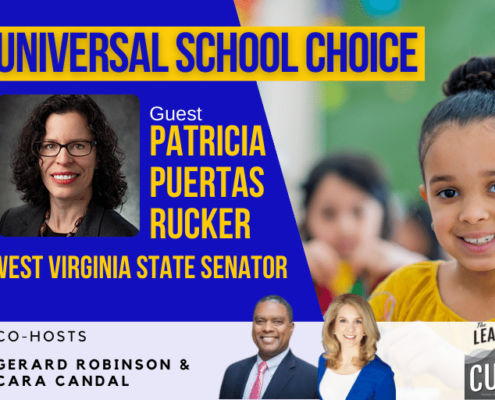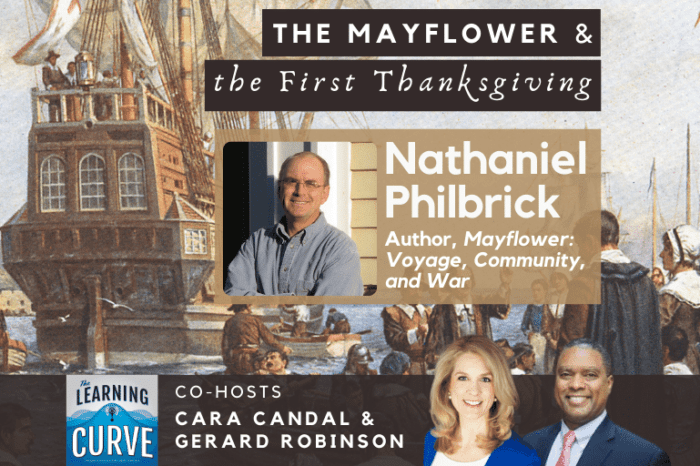Award-Winner Nathaniel Philbrick on the Mayflower and the First Thanksgiving
/in Featured, News, Podcast, US History /by Editorial Staff
This week on “The Learning Curve,” Cara and Gerard talk with Nathaniel Philbrick, historian, winner of the National Book Award, finalist for the Pulitzer Prize, and author of Mayflower: Voyage, Community, and War. Mr. Philbrick shares what we should know about the actual historical events of the First Thanksgiving in 1621. He describes who the Pilgrims were, their beliefs and educational traditions, and the obstacles they overcame to found Plymouth Colony. They review the seminal documents of this history, such as the Mayflower Compact, and lessons about the Pilgrims, Patuxets, Wampanoags, and their world. They discuss how the Native Peoples of 17th-century Massachusetts lived, worshiped, and governed themselves, and noted figures like Massasoit and Squanto. They also explore the experiences of Pilgrim and Native women, and their role in the First Thanksgiving. Lastly, Mr. Philbrick explains how the relationship between the Pilgrims and Native Peoples changed in the decades leading up to King Philip’s War. The interview concludes with a reading from his book, Mayflower.
Stories of the Week: Higher education is expecting to see a sharp enrollment decline over the next 20 years, in what industry experts are calling “the enrollment cliff,” as a result of declining birth rates during the Great Recession. Is the highly respected New York State Board of Regents high-school graduation exam on its way out?
Guest:
 Nathaniel Philbrick is the author of the international bestsellers In the Heart of the Sea, winner of the National Book Award; Mayflower: A Story of Courage, Community, and War, a finalist for the Pulitzer Prize; and Sea of Glory, winner of the Roosevelt Naval History Prize. His writing has also appeared in Vanity Fair, the New York Times Book Review, The Wall Street Journal, the Los Angeles Times, and The Boston Globe. He has appeared on the Today Show, the Morning Show, Dateline, PBS’s American Experience, C-SPAN, and NPR. He lives on Nantucket Island.
Nathaniel Philbrick is the author of the international bestsellers In the Heart of the Sea, winner of the National Book Award; Mayflower: A Story of Courage, Community, and War, a finalist for the Pulitzer Prize; and Sea of Glory, winner of the Roosevelt Naval History Prize. His writing has also appeared in Vanity Fair, the New York Times Book Review, The Wall Street Journal, the Los Angeles Times, and The Boston Globe. He has appeared on the Today Show, the Morning Show, Dateline, PBS’s American Experience, C-SPAN, and NPR. He lives on Nantucket Island.
The next episode will air on Weds., November 30th, with Peter Cozzens, the award-winning author of The Earth Is Weeping: The Epic Story of the Indian Wars for the American West.
Tweet of the Week:
Learning loss may be more severe now, but it is certainly not new. Joel Rose weighs in: https://t.co/qQ6jGQcakv
— Education Next (@EducationNext) November 22, 2022
News Links:
The incredible shrinking future of college
https://www.vox.com/the-highlight/23428166/college-enrollment-population-education-crash
NY Regents are looking to snap education standards out of existence
https://nypost.com/2022/11/20/ny-regents-are-looking-to-snap-education-standards-out-of-existence/
Get new episodes of The Learning Curve in your inbox!
Read a Transcript of This Episode
Please excuse typos.
[00:00:00] GR: Listeners, it is Gerard Robinson coming to you from Steel, beautiful Charlottesville, Virginia. Little more beautiful than last week, given this past weekend’s memorial service for the three young student athletes here at UVA who was shot and killed over a week ago. The community is still behind the family and.
[00:00:47] But things are moving. But again, it’s still a little more beautiful today. And of course, everything is beautiful when you add Cara to the conversation. So,
[00:00:57] GR: How are you doing?
[00:00:58] Cara: I’m doing okay. I [00:01:00] don’t, I don’t know if my kids would always agree that everything’s beautiful when I’m . No, Gerard we’ve been thinking of you and thinking of the people of Charlottesville a lot, as well as people in Idaho and Colorado Springs.
[00:01:11] I can’t believe that here we can just list in a matter of one week. Absolute tragedies that keep occurring. But I know that you’ve been, really feeling this as a member of the greater community and working to make sense of, what’s happened in Charlottesville, in this, really tragic loss of life.
[00:01:30] So, my heart’s going out to you and I think that this Thanksgiving Yes, listeners, we are coming up on Thanksgiving. hopefully we all have a little bit of time to reflect. On how fortunate we are those of us that have the ability to sit around a table with people that we care for.
[00:01:46] GR: exactly.
[00:01:47] And you and I being parents of children who play sports the professional and collegiate level, and even high school level athletes across the country have shown their support [00:02:00] in many ways of whether running onto a field with a uva. Flag or having a decal on a helmet or just writing a note.
[00:02:08] And it wasn’t just for football players, it was athletes across the country. And one of the reasons that we support athletics for young people, in addition to being good for the sole body in mind, is exactly this. It’s about the human spirit, not just competition, but coming around because you see each other.
[00:02:26] As one of your own. We are athletes, so I want to thank all the athletes and coaches across the country.
[00:02:31] Cara: Yeah, you’re here. I, I was thinking the same thing, Gerard, when my whole family woke up at 4 45 this morning to watch Argentina play ,
[00:02:39] GR: and if I’m not mistaken, there was a streak that was broken for
[00:02:44] GR: your country, right?
[00:02:45] Cara: Oh yeah. They did not win. They did not win. They did not win. We shall see, we shall see. But even in what is turning out to be a little bit of a controversial World Cup in terms of where it’s being held , and the behaviors of fifa, [00:03:00] you can feel how to your point, how it’s a global sport community and how people come together in very many important ways through,
[00:03:11] GR: Well, speaking of sports, that’s a nice segue into my article of the week, and it’s one of the ones I really enjoyed because it provided a good 360 degree view. Or overview of how we think about college enrollment in new ways. So this is from Kevin Carey, who is got a leadership position at New America and is titled The Incredible Shrinking Future of Colleges.
[00:03:39] So on our show we’ve talked to professors, entrepreneurs, and others who have a role in higher ed. And we know the challenges in higher ed. We know about funding, we know about. Student athletes, we know a lot of things, but we often don’t take a look at some of the external factors that influence college.
[00:03:59] [00:04:00] So the title alone pretty much
[00:04:02] GR: gives away what the author’s talking about. Colleges are shrinking. Exactly why. And so there’s several lanes the author walked and I wanna share with you and our listeners because it’s something for us to think about because it’s going to have a trickle effect on k12.
[00:04:17] So number one, we talk about college students. We often don’t talk about the fact that they’re part of a demography. And the demography, as we know it, it’s produced by families. And so what the author said is that if you wanted to look at when the real. Change in higher ed happened, go back to the recession of what we call the Great Recession in the early two thousands.
[00:04:38] So according to economists the great recession started in December, 2007, and it ended in June, 2009. And we know it was the housing bubble and a number of things. But I remember just the number of people who told me personally, they wanna have to delay retirement. Some of them says, you know what, I’m gonna hold off on going to college.
[00:04:58] And a number [00:05:00] of people, particularly young people, decided we’re not going to Have children right now. Well, that ended up playing a very interesting role into, , in what we’re talking about today because as the author noted to those who are gonna read the article, you usually see the birthing weight of children impact colleges 15 to 20 years later.
[00:05:19] So, for example, in 2010, Of women between the ages of 14 and 44 who were birthing age. You had basically from 1970 to 2007, you
[00:05:32] GR: roughly had 65 to 70 births per
[00:05:36] GR: 1000 women. Fast forward. To where we are right now, we’re roughly at 56 per thousand, which is the lowest in US history. So one of the reasons you have a shrinking college student body is simply because we have fewer people being born.
[00:05:52] One thing to keep in mind in terms of the demographic shift, number two, let’s take a look at undergraduate enrollment itself [00:06:00] in 2010. This is toward the end of the. Recession. We had 18.1 million undergraduate students enroll, which at that time was a record in 2019. Before covid, the number had actually decreased to 16.6 million.
[00:06:17] That’s a sizable decrease even before Covid or that we know that when Covid hit, a number of schools closed, a number of students went online. But we also know that a number of students who were enrolled at the time of Covid didn’t return. So there’s just a shrinking number of students who are going to college even before the pandemic.
[00:06:36] That’s something we’ve gotta consider. Also, let’s talk about high schools. You and I are big proponents of making sure students get a high school diploma. And one thing I can say with all the tragedies we have when we talk about NA and other things,
[00:06:48] GR: We have been pretty good about getting
[00:06:50] GR: students to and through high school.
[00:06:53] And right now we’ve got roughly 94% of young people who have a high school diploma. That’s one thing to cheer [00:07:00] about, but only approximately
[00:07:01] GR: 67%
[00:07:03] GR: are actually going to college. That could be a good or bad things. A lot of students are. Saying, Hey, I’m smart enough to go to college, but I wanna start a business.
[00:07:11] Or I want a credential. I wanna do something else. They’re doing other things, but it’s not because we don’t have students who have or lack a credential to get in. It’s just that many of their MA choosing not to go. Now let’s talk about regional impact and what it means for different parts of the country.
[00:07:26] So if you take a look at new. Which of course includes your state, but the author also identified Pennsylvania as part of that. Recently you had 372,000 people move into the state, move into the New England area, but 565,000 people actually left. So that was , a net loss of 200 and. A 238,000 people.
[00:07:51] The sad thing is that trend is gonna continue in the New England area for the next 20 years. Now, if you take a look at the South, totally different [00:08:00] story. There are at least 263,000 people that move to southern states. That’s also including Texas. As part of that, there, some people often include them in the west for this, it’s included in the south, and the south had 447,000 people abroad move there.
[00:08:16] And so for the. Major increase in the number of people who move there. Now, there is an economist at Carlton College in Minnesota who said, we’ve gotta do a better job of identifying these external factors that actually influenced education. so he created a higher education demand index. And what that index will do is take a look at demography which includes birth rates inward migration, outward migration jobs, and others.
[00:08:46] And he’s took a look at different regions and in some parts of the country, they’re gonna do well. So, for example, even with all the challenges that he identified in his study, he also identified. On the West Coast or the Western states, you’re gonna see a [00:09:00] 7.5% increase in the number of students who are going to enroll in schools in that part of the country.
[00:09:07] That’s a good thing, but he’s got some bad news. He said, you take a look at the Northeast and the Midwest. Not only will the college population drop for the reasons that I. , but the people who often earn a college degree in those parts of the country leave and don’t come back. And so you’re gonna have schools, particularly small colleges in New England and in the Midwest, that he says, you ultimately may find closing.
[00:09:33] And the last part of news, and this again isn’t great news because he’s predicting this is gonna. From now to the mid 2030s, if the West coast is gonna see an increase by 7.5%, guess what? New York, Ohio, Michigan, Wisconsin, Illinois, Louisiana, are gonna see a decline. 15% or more up until the mid 2030.
[00:09:55] So there is a shrinking number of students who are going [00:10:00] to college. Some of it we can’t control. Some of the things we can, I think, for the kind of work that we do, this is a nice wake up call. For the new governors who are interested in improving higher ed, they’re gonna have to also take a look. See what we have to do to make higher ed more attractive because they’re gonna to find ways to attract and keep students in school when there’s a shrinking population.
[00:10:22] What are your thoughts?
[00:10:24] Cara: I have so many thoughts, Gerard. I mean, the first is that when you tell me births are going down in our country, I look around my own house and think I missed that memo, . I also look around where I live in the Boston area and I think if people are leaving and nobody wants to come here anymore, why is the cost of housing still so high we.
[00:10:44] Such a crazy housing market, but no, in all seriousness, these are really important things and, really interesting predictions. I hadn’t really understood that about the Midwest. I understood it about the Northeast that people are leaving and that, here in the northeast we’ve seen small colleges [00:11:00] collapsing the unable to afford because of declining enrollment among other things.
[00:11:03] But I also think, and you touched upon this in the end of your. The other thing we all need to be thinking about as a society, as parents, as people who care about higher education. I actually have this as a dinner table conversation with my mother recently. I think increasingly folks are.
[00:11:20] Given the cost of college in, so many places, trying to consider what the real return on investment is or is going to be. And I think that it’s gonna be really interesting. More and more organizations and people are, thinking about how do we help families and students understand what really is the return on investment for a given degree or a given, educational path in higher ed.
[00:11:43] And that too, if we can get. Tight around that is gonna determine, you know, whether or not people are gonna continue to go to college. I think that certainly college degrees still mean something, but I don’t know that They mean the same things as they did. For example, in the 1990s when I went to [00:12:00] get a bachelor’s degree and thought, well, this is my ticket, right?
[00:12:03] One of the first people in my family, to be able to do that and thinking that was my ticket and it wasn’t. It’s, I think it’s got a different meaning today. But Gerard, this thinking about higher ed and entry into higher ed and who’s going to be going to higher ed is a really great link to my article from the New York Post.
[00:12:20] this is by the editorial board, so it is obviously an opinion piece. But it’s entitled The New York Regions are looking to Snap Education standards out of existence. New York Regents diploma. As you know, Gerard, for many students in New York State you can get a diploma diploma to graduate high school, or you can get a Regents diploma, which shows that you’ve met a higher standard, you’ve passed a certain set of standards and exams and for many kids in New York, that is a, really important ticket to higher education.
[00:12:50] And indeed, you know, institutions of higher ed, although they’re diverse in this country, many of the more competitive ones are still looking at. Things make test [00:13:00] scores, they say they don’t. Um, I think it’s still a differentiating factor in a lot of places, even though many places have gone, quote unquote exam optional.
[00:13:07] But seeing the kind of courses you’ve taken over the course of your high school career and understanding how you’ve done sort of even on state exams can be a really important component of the opportunities that open up to people in higher education and as is going on across this country in New York, there is an effort not just to water down standards, but.
[00:13:28] Abolish them to get rid of them altogether. We’ve talked about this a little bit before on the learning curve. This idea that is accountability dead? Has the pendulum swung back to a place where nobody wants to talk about standards and testing, let alone enforce them anymore? And the pandemic seems to have.
[00:13:45] we knew it was gonna open up this space. Let’s put tests on hold. Let’s put teaching to teaching to a curriculum on hold, and that the pandemic was gonna open up this space for those who are detractors of standards and detractors of test based accountability [00:14:00] that can help us understand. Not only how students are performing, but much more importantly how schools are performing.
[00:14:05] Are these gonna go away because, they’re inconvenient. They’re inconvenient for some, and it looks like that is what is set to happen in New York. The education commissioner there is speaking out very powerfully. Saying that she wants to see these exams go away. And her allies on the Board of Regions, and this is, I’m talking about Commissioner of Education, Betty Rosa, her allies on the Board of Regions seem poised to make this happen.
[00:14:33] New York aside, Gerard, this. won’t surprise anybody. This scares me on any number of levels. But the first level on which it scares me is number one. You know, one of the arguments that folks who don’t like standards and accountability often use is that they’re somehow unfair and that they’re slanted against those who have the least access.
[00:14:51] They can also sometimes provide opportunity for those who we, as we think of as people who are coming from disadvantaged backgrounds [00:15:00] many times children from backgrounds. We, you and I might consider to be disadvantaged can flourish if given access to the right curriculum can flourish if given the opportunity to show that they can succeed on an exam like the regions.
[00:15:13] And so for some people it’s, a ticket. Up and into higher education. I worked in testing for a long time, and I can tell you there’s a lot of bias and sensitivity vetting that goes on and I don’t buy the argument that these tests are unfair. And importantly, the reason I really don’t buy the argument is because used well.
[00:15:32] Standards, put everybody on the same page. And when we hold folks accountable to teaching to standards, and we use accountability as a tool, something like the Regents Exam as a tool can really shine a light on when schools aren’t teaching to standards, when schools aren’t teaching kids at all Again and again, I’ll say it, we know this because of no child Left behind.
[00:15:52] There were really important components of that law that worked, and now we want to kind of throw the baby out with the bath water because we don’t like [00:16:00] that these tests can be stressful. Instead of thinking about reforming them or how to use them better, we are thinking about getting rid of them all together.
[00:16:08] The other thing I would point out here is we have very good evidence that standards, exams, in fact, like end of course examinations, like the new regions exam, not only provide opportunities for people to go on to higher education, whatever kind of higher education they might choose, but they also send a really important signal to the labor market.
[00:16:28] So if I have, for example, a region’s diploma, it can send not only a signal to higher educat. But to the labor,, market to say I have command of a certain set of competencies and skills that can help me be really successful. I mean, at a basic minimum, employers wanna know that somebody can read, write, and compute competently.
[00:16:48] So here’s the confluence of our two stories, Gerard. I think just as we’re thinking about what is the future of higher education, we also have to think about if we dismantle some of these fundamental components of K to [00:17:00] 12 education. That might not always be the most fun, but are really important tools for helping policy makers and others understand how schools are doing.
[00:17:08] We might be having entirely different conversation about what the future of higher education looks like in our country. So what do you think about that in the few minutes that we have?
[00:17:17] GR: I think that opportunity minus opportunity equals equity of no opportunity for. Because I often hear that we want to have more equity and therefore we should get rid of tests like this or at the K12 level the whole exam school option in New York for the sake of equity.
[00:17:38] I just don’t see how getting rid of opportunity for everyone is gonna give you equity for all. It just gives you equity of all, having no opportunity to. The Regents Exam, I’m in total agreement with you in terms of signaling and any time at Elite Colleges. So what, you know, the article, the author of my article mentioned is that, Indiana, [00:18:00] your alma mater, university of Chicago, your alma mater Boston, U your alma mater, Harvard, Howard Mine.
[00:18:07] Those schools are gonna be fine because there is a direct line, not
[00:18:12] GR: only from alumni to students who want to go
[00:18:14] GR: but signaling with the regents degree at a place where there’s a select number of seats for scholarships. It makes a difference. And if you’re first in your family to go to college like me it’s actually a, an additional feather to say, well, you know, We’ve got one seat left.
[00:18:29] We’ve got five candidates. Oh, Gerard is the only. Who’s got a Regents diploma, let’s put him in for this reason. And he’s also African American and male and all those things. So, I just think we’ve gotta do a better job of trying to find ways to address equity because signaling matters. And when I talked about the 447,000 plus abroad, who’ve come to the south, we’re not talking about the thousands who come to the West Coast and other places.
[00:18:54] Immigrant families who I know, who I’ve worked with, when they come. They want their [00:19:00] children to have access to every single possible opportunity to give their children an advantage. And yes, they may be, quote unquote, disproportionately involved or subscribed into high testing classes and others. That’s an issue of us preparing our students better.
[00:19:19] But I can tell you, you’re gonna find the backlash coming from immigrant families, not just Asian families. Families from Nigeria uh, and parts of the craving as well. So I’m with you on this. Not that my 2 cents makes a difference to people in New York, but hopefully they will rethink that opportunity.
[00:19:36] GR: Yeah.
[00:19:36] Cara: Or watch the standard of education in that state tank. Okay, Gerard, hard pivot here because coming up we’re gonna be speaking with Nathaniel Philbrick. He is an American historian and a National Book Award winner, and I will read the rest of his accolades right after this.[00:20:00]
[00:20:14] Learning Curve. Listeners, as promised, we are back with Nathaniel Philbrick. He is the author of the International Best Sellers in the Heart of the Sea, winner of the National Book Award, and Mayflower, A Story of Courage, community and War, A finalist. For the Pulitzer Prize. He’s also a writer of Sea of Glory, winner of the Roosevelt Naval History Prize.
[00:20:34] His writing has also appeared in Vanity Fair, the New York Times book review, the Wall Street Journal, the Los Angeles Times, and the Boston Globe. He’s appeared on the Today Show, the Morning Show, Dateline PBS’s, American Experience, CSPAN and npr, and he lives on Nantucket Island. Beautiful place to be now and probably always Nathaniel Philbrick.
[00:20:54] Welcome to the show.
[00:20:56] Nathaniel: It’s a pleasure to be here.
[00:20:57] Cara: We’re really happy to have you and what an [00:21:00] appropriate time of year.
[00:21:33] So you are here to tell us a bit about the real story, not the mythical story of Thanksgiving. could you start like with it for our listeners, what, should we really know
[00:22:24] Nathaniel: about the first Thanksgiving?
[00:22:28] Is you know, there is the myth of, Victorian era dress of people gathered around their hands collapsed praying as they eat their Turkey and, pumpkin pie with a few curious native Americans. Looking on, and that’s not anything like what the actual Thanksgiving was.
[00:22:45] In fact, it wasn’t a Thanksgiving. It had more in common with a harvest festival. It wasn’t in November, it would’ve been late September and October. For them it was a celebration of having [00:23:00] lived through that first horrible winter in which. The pilgrims died and then having, thanks to the intervention of the wano leader Mass.
[00:23:08] So, and Squanto and several other. Wampanoag you know, they had planted crops and they, they had something, they had a bounty to enjoy. And so this was a harvest festival. It would’ve been outside. There were, you know, about less than 50 survivors from that first winter. And in fact it would be primarily a native event because about a.
[00:23:33] Poconos a group of of Wampanoag arrived with a couple of freshly killed deer. And, there was too many of them to sit around a table. They just didn’t have the furniture. It would’ve been an outdoor thing around fires where duck and perhaps some turkeys who turned on a spit with pots stews and things like that happening.
[00:23:54] And so, You know, there was a lot of oppression, obviously at Plymouth Colony, but [00:24:00] for this, this was a point at which. The thanks to the WAC who had extended a kind of olive branch and had not wiped them out as they could have they had survived. And in this one specific moment in history there was actual cooperation between two very different peoples.
[00:24:18] Because they were both survivors. The Wano had been almost wiped out by European disease, yet three years before the, arrival of the pilgrims. And they, they felt they needed an ally when it came to the, rival na answers. So, there is some truth to the first Thanksgiving and I think it’s important to see.
[00:24:40] In its cultural terms not as, as that mythic stereotype. These are real people who were celebrating a brief moment in which they were working cooperatively.
[00:24:52] Cara: Well, so, sort of a lovely kernel of hope and an otherwise pretty depressing story from both perspectives, it sounds. [00:25:00] So I wanna talk about both groups that participated in that first Thanksgiving, but let’s first most of us know where the pilgrims came from.
[00:25:07] Again, if we have gone to American schools, right? Fleeing religious persecution. They were actually first in Holland and then they make this long voyage over to what was then called the New World. So talk to us a little bit about who these people were the obstacles that they had to overcome, and can we even begin to imagine that voyage, what it must have been like?
[00:25:31] Nathaniel: Oh, it was a, a voyage from hell. It really was. Well, you know, these were religious separates and I think it’s a, a common misnomer. They, you know, they fleeing for religious freedom. No, they were fleeing so that they could. Worship as they pleased and would not tolerate anyone else. Basically they were looking for their own personal religious freedom.
[00:25:53] they were separatists who believed that they needed to pull away from the Church of England and worship [00:26:00] God in as direct way without the, symbols and imagery of, of the traditional church. And this was illegal in England. So that had led them to go to the more tolerant scene in Holland.
[00:26:13] But in Holland their children were becoming Dutch and they were proudly English what to do. Well, there was the Colony of Virginia that extended all the way up. New York, and that was their hope is they bet the farm on a crazy idea of going across the ocean to the new world as they called it, and it would prove to be, were religious.
[00:26:36] Enthusiasts who were not necessarily good at organizing an expedition and things went bad from the very beginning. They purchased the inappropriately named speed, well, a vessel that would cause them ceaseless headaches and delay their ultimate departure from England when they had to abandon the speed well and go in their other vessel of paying the Mayflower.
[00:26:58] And by this time [00:27:00] their original ambition had been to. In the New World in beginning of summer with plenty of time to build houses to protect them. From winter, it was September where they left Plymouth, they England after a series of delays. And it would be, late fall. By the time they finally reach the new world, they were hoping to go to New York, they would end up off the tip of Cape Cod in Massachusetts.
[00:27:25] after almost destroying the ship on some SHOs off the south shore of Cape Cod decided that they had no choice but to go for what we call Massachusetts now. And so, it was late people had already begun to die of sickness. And they had no idea about anything as far as where they were.
[00:27:46] It was about the worst circumstances you could possibly have to begin a colony in the Americas.
[00:27:52] Cara: So, again, another part of the story that we don’t, think about very much. One can barely even imagine today. [00:28:00] On a cruise ship. I can’t even imagine a 10 week voyage to do it at that time with so few resources and in such dangerous conditions.
[00:28:07] It’s absolutely amazing to think about.
[00:28:09] Nathaniel: it was a hundred, two of them. And half of them were separatists and the other half were not. So from the beginning there were divisions within this group and it wasn’t the monolithic pilgrims. It was a more complicated aspect, which I think is important to.
[00:28:24] Cara: Yeah, absolutely. And of course spending that much time in close quarters with group divisions, an amazing story. So, one of the ways, if, they’re lucky that students will learn about history, will learn about the past is through primary source documents. And, many of.
[00:28:43] Have, if we might not be able to remember its contest, but we’ve heard of the Mayflower Compact and the Plymouth Colony leader, William Bradford. He has a, famous journal from 1630 to 1651 was of Plymouth Plantation. What do these particular [00:29:00] accounts tell us about the pilgrims as well as the wpa, Noahs and the world that they each, that they coexisted in for that.
[00:29:10] Nathaniel: Yeah, well, let’s start with a Mayflower Compact. It’s an extraordinary document. They realized that they were going to have to go to a part of the new world for which they really didn’t have legal right to go. And so there was a bit of, I won’t call it an insurrection, but a disagreement between the.
[00:29:28] The Purs and those that didn’t necessarily believe in those beliefs and with some of them saying they would go their own way once they got on land, which would been a disaster for everyone. And you know, they had miles, Standish was their military officer and they could have looked at him to subdue the rebels, but instead, They created the Mayflower Compact, which was an agreement by everyone on all the passengers and this is what makes it interesting that you know this, these were religious enthusiasts, but this was a [00:30:00] civil document by which everyone agreed.
[00:30:02] to mine the, laws of their civil leaders. And so given the circum, you know, some people have said, oh, you know, it’s the US Constitution in utero. It was not that by any means. It wasn’t very much different from Something you might find in England. But the circumstances or what make it extraordinary?
[00:30:21] You know, here they are at the end of their known world with things falling apart. And what do they do? They put pen to paper and create a document that we still look to as, , essential in the history of this country. And then for me as a histor, These documents are so important. One of the joys of working on this book was actually holding William Bradford’s of Plymouth Plantation, which is in the Massachusetts archives.
[00:30:47] iIt looks like it was written yesterday. It’s in such great shape. And in it, Bradford tells the story of Plymouth Plantation in details [00:31:00] that bring to life , the various characters, but also the English struggles with the native people there at.
[00:31:06] Tends forge a compact an understanding with mass. So, how things went bad and there was violence at various times. How they then came to other agreement. And it, it really it’s a document that is very human that really gives you the sense of. Unknowing that they had. I think there’s a tendency to think, oh, the pilgrim fathers, they knew what they were doing from the start, but the reality is they were, they had no clue what was going on.
[00:31:33] They didn’t know where it was headed. They were surprised and terrified at the turn of events just about everywhere they went. And this is a chronicle of their attempts to sort of make their way day by day in this new world of completely different circumstances than what they had left.
[00:31:51] It
[00:31:51] GR: just sparked my interest regarding Bradford and holding the book today. It’s easy for many of us to look [00:32:00] backward in comfortable rooms, air conditioned rooms, maybe at this time of year with a fire to say they had it made. They knew exactly what they were doing, and in fact, you say they were building as they were going.
[00:32:11] Is there any one or two particular things that you learned? About that community that was even an aha moment for you as a historian that you think we as contemporary Americans
[00:32:22] Nathaniel: should listen to? Yeah. Well, one of the things that I had not really fully appreciated before I, I got into the research for this book was How completely ignorant the pilgrims were of their new surroundings. You know, they, marched along. north shore of Cape Cod in search of a navigable river . There aren’t, there, are there barely creeks in that section? They really had no clue where they were going. I mean, not even a map to really guide them.
[00:32:52] and every time they would come across signs of Native peoples they would make the terrible mistakes. You know, they came across some [00:33:00] corn that had been buried for later use. What did they do? They stole it. they, went into native houses and, eventually they came to, is still known as First Encounter Beach on Cape Cod, and I knew about First Encounter Beach.
[00:33:14] I, you know, I’m pretty familiar with the case, but I have to tell you, you, if you go out there, Particularly at the time of year, around this time of year that they were trudging their way and sailing their way along. You can just see how bleak it was. And it was there that they encountered a group of lo warriors and there was a confrontation where they’re firing at each other arrows whistling through the air, and no one was hurt, but What that established was you know, what the heck were they in the middle? What had they done? Had they stirred the hornets nest and was it about to consume them? could they actually do some kind of form of diplomacy and, and write the situation that they had messed up so much? You [00:34:00] know, for me, that was the moment where you realize, you know, it’s two people that are, don’t understand each other, are naturally terrified of each other, and where is it gonna go from?
[00:34:12] And I think the remarkable thing is that there would be some kind of a compromise reach that would all blow apart eventually, but on that beach, it all begins, that
[00:34:24] GR: beach and the other encounters later on. We often talk about it from the perspective of the men. In war, men in negotiation, you’re well aware that there were women involved across the
[00:34:36] GR: board.
[00:34:37] From your
[00:34:38] GR: research, could you talk to us about pilgrim and native women, what their lives were like and what was their role? Not only in what we call the first Thanksgiving, but just the interactions that you just described.
[00:34:50] Nathaniel: Yeah. Well, one of the important figures for. Because it’s hard to get at this just given the evidence.
[00:34:56] There’s so little of it. The accounts we have [00:35:00] are either written by men or focus on men. Native endings is just not a lot of information, and yet you can get from the, peripheries of the story. there’s evidence not. By William Bradford is really what would happen to his own wife?
[00:35:18] the circumstances of her dying. She would as Bradford and this group of Pilgrims were searching for what would ultimately be of settlement at, at Plymouth. Dorothy is back on the vessel with other women and, and other. Pilgrims and at some point she slips over the edge of the Mayflower and drowns.
[00:35:38] We will never know exactly what happened, but I think there’s a real possibility that it was despair that drove her to this point here in this terrifying state, of not knowing that she had left her son back with friends in. And she didn’t know what was going to happen to her husband on this, this expedition.
[00:35:59] And [00:36:00] so, for me Dorothy Bradford is, one of those symbols of the knot of, of the what little we know and yet how much emotional life was invested in, in what they were going through. In terms of native women the focus is always on quato and, na.
[00:36:17] So, but it was the women who were planting. crops that sustain not only the but the pilgrims. And so, there’s whole elements of life that are hard to get a, a read on given the, what we know in terms of the documents. But still we must do everything we can to tell their.
[00:36:37] So
[00:36:38] GR: here’s a final question for me. So, you know, your excellent book covers approximately 55 years. From the Mayflower voyage ahead of King Phillips war with the native inhabitants and of course that changed their lives, lives of the natives as well as those who were there. Would you discuss how the relationship between the Pilgrims and the [00:37:00] Natives people changed in the decades following what we call the first Thanksgiving and what it should teach our students and educators today about, let’s say the Fury, religion, war in race
[00:37:11] Nathaniel: in early America.
[00:37:12] Well, you know, I didn’t wanna end this book with the first Thanksgiving because I thought what the story you, to do it justice, you had to go to the next generation because circumstances changed at the time of the first Thanksgiving, as I said earlier. Both the pilgrims and wana needed each other in terms of their own cultural survival.
[00:37:35] But things would change as more and more English would arrive in Massachusetts. 10 years after the, the voyage of the Mayflower, the purs would begin to arrive in. And soon you’d have this inundation of English peoples. And as this was happening the negotiations that the pilgrims had undergone with the for land would heat up these kinds of things.
[00:37:57] And soon there as the population [00:38:00] increased on the English side, This hunger for land meant that the second generation began to have a very different attitude towards their native neighbors. Rather than seeing them as indispensable to serve their survival, they saw them as possessing the land they desired.
[00:38:17] on the Wampanoag side, if you are a young warrior who you could see that your prospects were nothing compared to what your, the previous generation had had, thanks to the arrival of these English, and you became increasingly angry about it. And what would happen? 50 years after the voyage of the Mayflower would be King Phillips.
[00:38:38] the bloodiest war ever fought on American soil in terms of the percentage of population killed. Half the English villages towns in, in Massachusetts would be burned in, abandoned at one point And the native side would be absolutely decimated in this terrifying conflict that would last a little less than two [00:39:00] years.
[00:39:00] , and, I think it speaks to the importance of remembering as Philip, whose native name was Metacomet, would say. when you first came here you were as a little child and my father was the one that allowed you to live. Now here, you have grown up and what are you doing?
[00:39:20] You forget completely that the fact that you’re, you’re here today and flourishing was because of this bargain you made with my, And so, it’s a lesson that needs to be constantly remembered and refreshed and will regrettably be forgotten as all of us hurdled into the future.
[00:39:39] But it’s the, I think the ultimate meaning of the story of the Thanksgiving is what would happen later with the next generation where all that promise would be.
[00:39:49] GR: Well, speaking of your excellent book, we wanna provide you an opportunity to read a passage of your choice before we close.
[00:39:57] Nathaniel: Well, thank you. I think what I [00:40:00] will read since we’re running around Thanksgiving is a paragraph that talks about what that first Thanksgiving was really.
[00:40:10] Countless Victorian era engravings. Not withstanding, the pilgrims did not spend the day sitting around a long table draped with a white linen cloth, clasping each other’s hands and prayer. As a few curious Indians looked on instead of an English affair, the first Thanksgiving soon became an overwhelmingly native celebration when Massasoit and a hundred more than twice the entire English population of Plymouth.
[00:40:36] Arrived at the settlement with five freshly killed deer. Even if all the pilgrims furniture was brought out into the sunshine. Most of the celebrants stood squatted or sat on the ground as they clustered around outdoor fires where the deer and birds turned on wooden spit and were pots stews into which varieties of meats and vegetables were thrown simmered [00:41:00] in bit.
[00:41:01] And so that’s a paragraph describing what that first celebration probably was like
[00:41:07] Cara: beautifully written. Nathaniel Philbrick, thank you so much for spending time with us right before Thanksgiving. What a wonderful lesson and an enjoyable conversation that I hope we can all take to the Thanksgiving table with us this year.
[00:41:21] Nathaniel: Right. Well, it’s been a pleasure and may everyone have a great Thanksgiving.
[00:41:26] Cara: You too. Happy Thanksgiving. Please take care.[00:42:00]
[00:42:02] GR: So my
[00:42:03] GR: tweet of the week is from Education. Next November 21st, learning loss may be more severe. But it is certainly not new, and it’s a really good piece basically telling you everything you need to know from the title. So I won’t spoil it. That’s my.
[00:42:19] Cara: it’s a little depressing, but I’m gonna go ahead and read.
[00:42:21] Anyway, Gerard well first of all, I’m wishing you an amazing Thanksgiving as amazing as it can be given everything you’ve been going through lately. Next week we are gonna be speaking with Peter Cousins and he’s the award-winning author of the Earth’s weeping. The epic story of the Indian Wars for the American West.
[00:42:40] So we are going to continue a focus on this country of ours historically speaking and where we are today. Until then, Gerard, I was you and your family peace and love and, a wonderful meal with people that you care about.
[00:42:56] GR: Same to
[00:42:56] GR: you, same to our listeners. Let’s be thankful [00:43:00] for what we have.
[00:43:01] I am
[00:43:02] Cara: thankful for you, my friend.
[00:43:04] GR: Ditto. Take care.
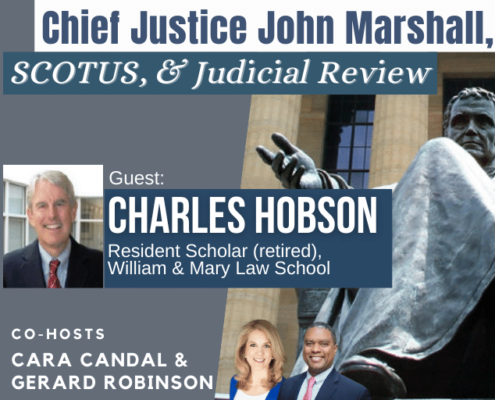
William & Mary’s Dr. Charles Hobson on Chief Justice John Marshall, SCOTUS, & Judicial Review
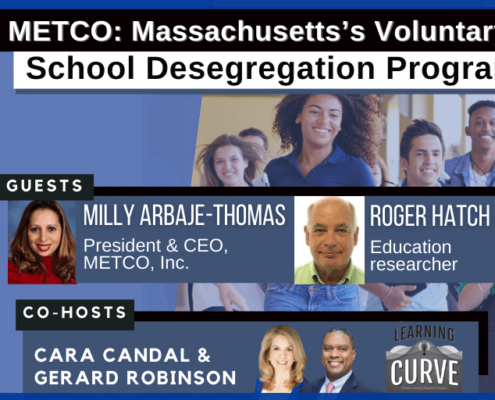
METCO’s Milly Arbaje-Thomas & Researcher Roger Hatch on MA’s Voluntary School Desegregation Program
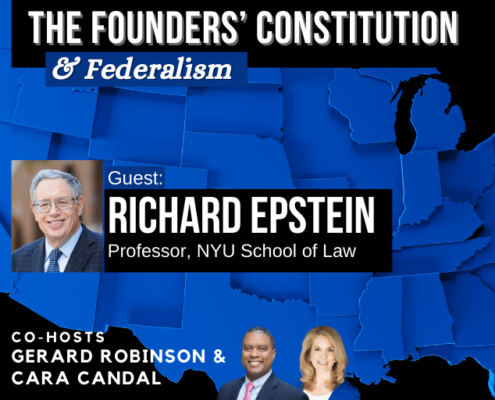
NYU Law Prof. Richard Epstein on the Founders’ Constitution & Federalism
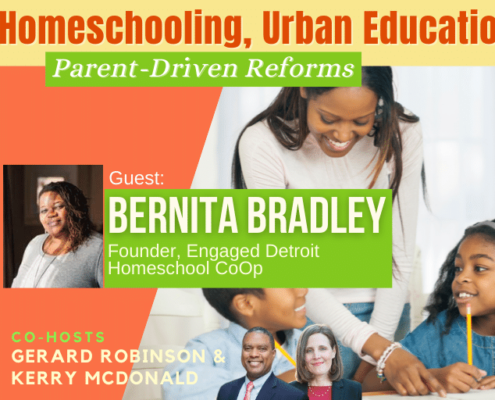
Engaged Detroit Founder Bernita Bradley on Homeschooling, Urban Education, & Parent-Driven Reforms
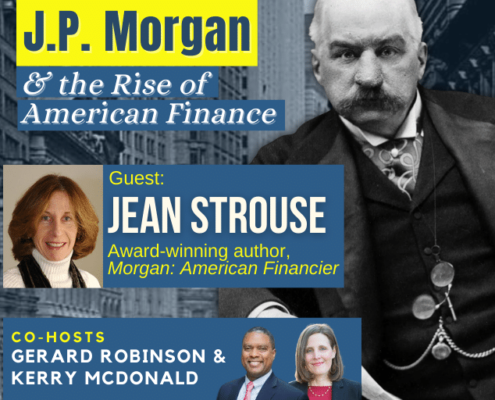
Jean Strouse on J.P. Morgan & the Rise of American Finance
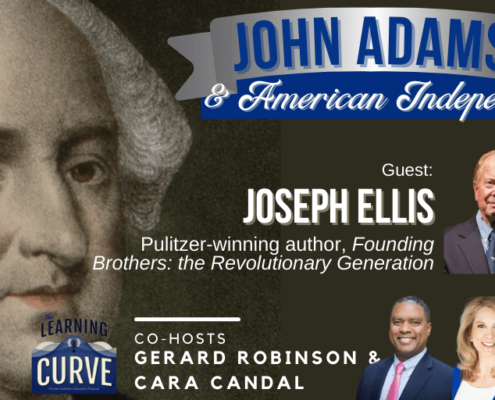
Mt. Holyoke’s Pulitzer-Winning Prof. Joseph Ellis on John Adams & American Independence

Lead Plaintiff David Carson & IJ Attorney Arif Panju on Landmark SCOTUS Decision Carson v. Makin
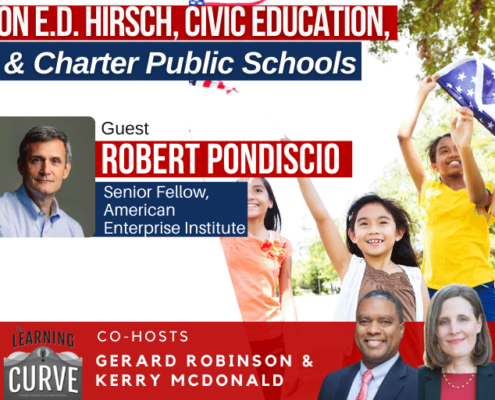
AEI’s Robert Pondiscio on E.D. Hirsch, Civic Education, & Charter Public Schools
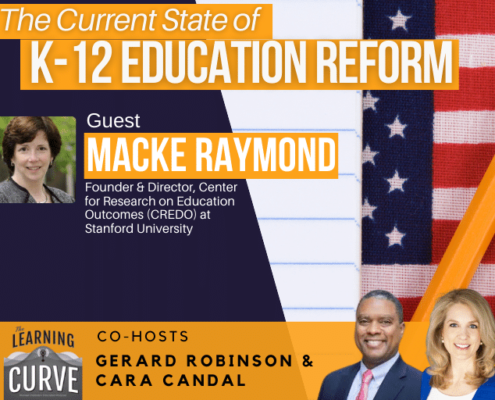
Hoover at Stanford’s Dr. Macke Raymond on the Current State of K-12 Education Reform
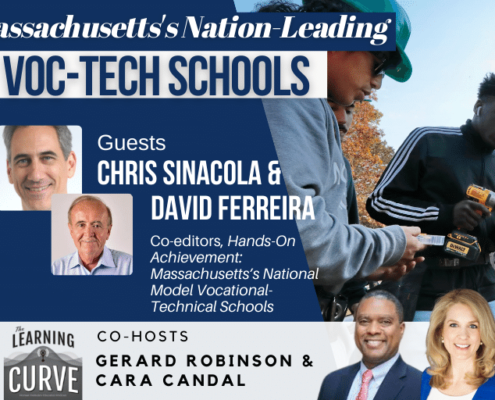
David Ferreira & Chris Sinacola on MA’s Nation-Leading Voc-Tech Schools
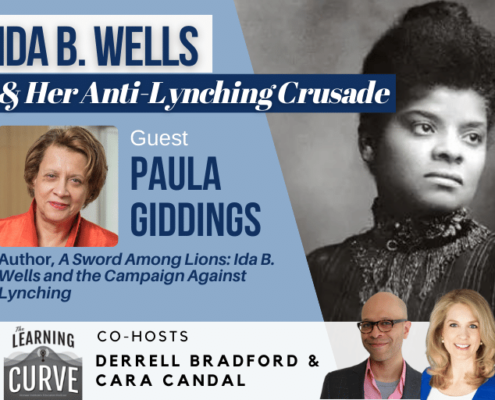
Smith College Prof. Paula Giddings on Ida B. Wells and Her Anti-Lynching Crusade
